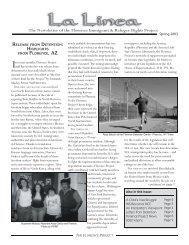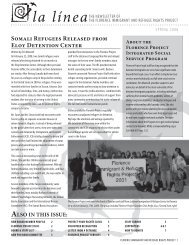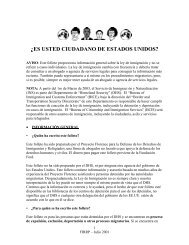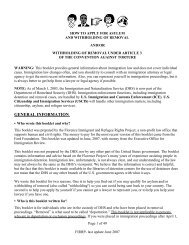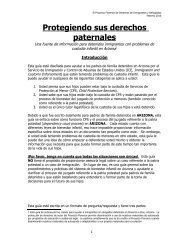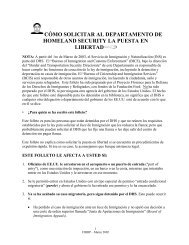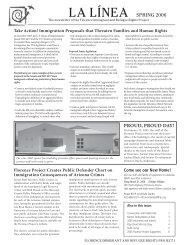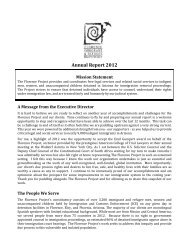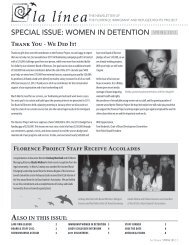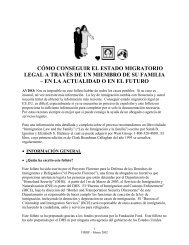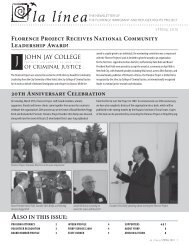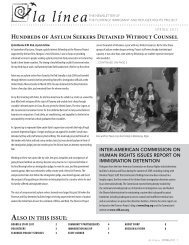quick reference chart and annotations for determining immigration ...
quick reference chart and annotations for determining immigration ...
quick reference chart and annotations for determining immigration ...
You also want an ePaper? Increase the reach of your titles
YUMPU automatically turns print PDFs into web optimized ePapers that Google loves.
Immigrant Legal Resource Center, Florence Immigrant <strong>and</strong> Refugee Rights Project,<br />
Maricopa County Public Defender August 2012<br />
conviction <strong>for</strong> helping someone who may have committed a drug offense, firearms offense, or sexual<br />
offense is not itself a drug, firearms, or sexual offense conviction.<br />
However, the BIA has held that that accessory after the fact does constitute “obstruction of<br />
justice,” <strong>and</strong> there<strong>for</strong>e is an aggravated felony under 8 USC 1101(a)(43)(S) if a one-year sentence is<br />
imposed. Matter of Batista-Hern<strong>and</strong>ez, 21 I&N 955 (BIA 1997) (accessory after the fact is not an offense<br />
“relating to controlled substances” but is an aggravated felony as obstruction of justice if a one-year<br />
sentence is imposed); Matter of Valenzuela-Gallardo, 25 I&N Dec. 838 (BIA 2012). While the BIA held<br />
in Matter of Espinoza, 22 I&N 889 (BIA 1999) that misprision is not obstruction of justice even if a oneyear<br />
sentence is imposed, that decision relied on the absence of a specific intent in the federal misprision<br />
statute. Matter of Valenzuela-Gallardo, 25 I&N Dec. at 841 (“[t]his element—the affirmative <strong>and</strong><br />
intentional attempt, with specific intent, to interfere with the process of justice—demarcates the category<br />
of crimes constituting obstruction of justice”). Since Hindering requires “the intent to hinder the<br />
apprehension, prosecution, conviction or punishment of another,” it will likely be found analogous to<br />
accessory after the fact, rather than misprision.<br />
The Ninth Circuit <strong>and</strong> the BIA currently disagree on whether obstruction of justice requires<br />
“active interference with proceedings of a tribunal or investigation.” See Hoang v. Holder, 641 F.3d<br />
1157, 1161 (9th Cir. 2011); Matter of Valenzuela-Gallardo, 25 I&N Dec. 838 (BIA 2012). Hindering<br />
does not require that there be an ongoing investigation or prosecution in order to be convicted under the<br />
statute. There<strong>for</strong>e, counsel should attempt to plead to a factual basis that suggests there was no ongoing<br />
investigation or prosecution at the time of the offense in hopes that the Ninth Circuit’s position will<br />
ultimately prevail. But <strong>for</strong> the time being, counsel should assume that any Hindering conviction with a<br />
sentence of one year or more will be an aggravated felony.<br />
There may also be some dispute about whether a Hindering offense that was committed during a<br />
police investigation, but be<strong>for</strong>e a <strong>for</strong>mal judicial proceeding was commenced qualifies as an obstruction<br />
of justice. Compare Salazar-Luviano v. Mukasey, 551 F.3d 857, 863 (9th Cir. 2008) (escape that<br />
occurred after arrest but be<strong>for</strong>e the commencement of any judicial proceedings is not obstruction of<br />
justice), with Hoang v. Holder, 641 F.3d 1157, 1165 (9th Cir. 2011) (obstruction of justice includes<br />
offense in which defendant “provided assistance to an individual who was subject to a pending judicial<br />
proceeding or ongoing police investigation”). Defense counsel should create a factual basis that leaves<br />
open the possibility that the Hindering offense was committed be<strong>for</strong>e a police investigation was initiated.<br />
Crime Involving Moral Turpitude. The Ninth Circuit has held that accessory after the fact<br />
under Cali<strong>for</strong>nia law is not categorically a crime involving moral turpitude. Navarro-Lopez v. Gonzales,<br />
503 F.3d 1063 (9th Cir. 2007) (en banc) (overturned on other grounds). It also recently held that a<br />
misprision of a felony under federal law is not a CMT because it does not require a specific intent to<br />
conceal or obstruct justice, but only knowledge of the felony. Robles-Urrea v. Holder, 678 F.3d 702, 710<br />
(9th Cir. 2012). But since Hindering requires “the intent to hinder the apprehension, prosecution,<br />
conviction or punishment of another,” it may be found a CMT under Robles-Urrea. However, the BIA<br />
has held that accessory after the fact is only a CMT if the underlying offense in which the principal<br />
engaged is a CMT. Matter of Rivens, 25 I&N Dec. 623 (BIA 2011). There<strong>for</strong>e, counsel should assume<br />
that Hindering will be a CMT but attempt to plead to accessory of a non-CMT offense in order to leave<br />
<strong>immigration</strong> counsel arguments against this.<br />
IMPORTANT: Recent case law has altered the process by which <strong>immigration</strong> judges decide<br />
whether an offense is a CMT. See Matter of Silva-Trevino, 24 I&N Dec. 687 (A.G. 2008). While judges<br />
Arizona Criminal Chart with Explanatory Endnote – August 2012<br />
73



